In the 1990s, Industry analyst Gartner coined the term Enterprise Resource Planning (ERP) as a name for the category of software products aimed at supporting companies’ internal business processes.
With the rapid proliferation of the internet, the term was later extended with the suffix “II” to allow for the inclusion of software with functionality supporting inter-company business processes.
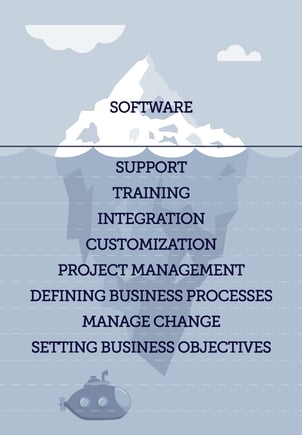 Today, virtually every company in the world has implemented an ERP system. The category, expected to reach an annual global market turnover of between 50 and 70 billion USD in 2025 (CAGR: 10 per cent), makes up one of the most significant segments in the software industry. Hundreds of thousands of people are engaged in developing, implementing and supporting ERP software, and millions depend on it daily to do their jobs.
Today, virtually every company in the world has implemented an ERP system. The category, expected to reach an annual global market turnover of between 50 and 70 billion USD in 2025 (CAGR: 10 per cent), makes up one of the most significant segments in the software industry. Hundreds of thousands of people are engaged in developing, implementing and supporting ERP software, and millions depend on it daily to do their jobs.
Why change it if it isn’t broken?
When ERP systems are down, companies standstill, production comes to a halt, orders cannot be picked and shipped, invoices cannot be submitted, and payments cannot be collected.
These systems are mission-critical, which is why companies are reluctant to replace them once they work. However, the world doesn’t stand still, and you cannot survive unless you continuously improve your customer value propositions and, at the same time, increase your productivity. Providing more value to customers at lower unit cost requires investments in new technology, and software is increasingly becoming the key value and productivity enabler.
Nevertheless, if companies already have ERP systems in place, then how come industry analysts predict that they (the companies) over this decade will spend close to one trillion dollars extending and replacing them?
And the software is only the tip of the iceberg.
Changing ERP software comes with substantial implementation costs and organizational disruption. The total spend in this domain may well approach the ten trillion-dollar mark.
That’s a lot of money, change and risk.
Adding more users to what they already have cannot amount to trillions of dollars.
What will all that investment be used for? What is it that companies will want that they don’t have today?
Check the communication from the main suppliers and the industry analysts. You will mostly find technical hype such as digital transformation, artificial intelligence, machine learning, predictive analytics, citizen development, augmented reality, blockchain, cloud computing, software-as-a-service, systems integration, IoT and many other technology-related terms.
It reminds me of the days when car brochures elaborated on the full-feeding systems. There were pages with details on carburettors, fuel injection, compressors and turbo systems. Today, most of the under-the-hood technology is irrelevant to the prospective buyer. The key issues are usability, comfort, safety, environment and price/performance.
Providing a guess on what companies may want to spend trillions of dollars on in their future ERP systems, I think we need to apply a different perspective.
Check out what costs SMBs need to consider when evaluating different ERP systems.
The end of the hype cycle?
Up until now, the ERP software market has primarily been driven by suppliers and their need to sell new technology. The results have been somewhat disappointing.
In a recent study, about every second company asked had experienced a material operational disruption at the time of go-live with a new ERP solution. The duration of disruptions varied from a few weeks to several months. These disruptions increased the initial cost of the implementation from anywhere between 50% to 300%[1].
On top of the severe implementation issues, we often also see projects that fail entirely stopped and written off[2].
I am convinced that the market for ERP software is maturing and that customers, faced with the need for faster and faster improvements of their value propositions and business models and for extending their geographical reach, will demand solutions that are made of standard components that can be easily integrated and where the customization and implementation can be partly in-sourced and done faster.
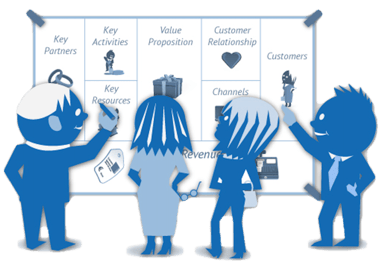
However, blaming the high rate of failing ERP projects on the vendors only isn’t fair. Scope creep, lack of executive leadership and inadequate change management measures have also made significant contributions.
Read about what key ingredient is needed for a successful ERP implementation.
With most companies now on a more advanced learning curve (using business management software), with less room for mistakes and the need for faster and more frequent changes, I believe we will see material shifts in demand and adoption.
The customers didn’t define the category ERP, and as software creeps into all corners of any enterprise, it becomes less and less meaningful to cling to the term. Across the market, we will see demand for software to support all business processes. Adding an artificial border between functional areas that need to be tightly integrated doesn’t make sense. I suggest we see the term ‘business management software’ emerging as the new category headline among end-users. The term ERP will not disappear, but it will, together will all the other technical jargon, increasingly be used by vendors and industry analysts.
To understand how the business management software market dynamics will change, I suggest we revise a few definitions.
The demand side of the market
Any market has a demand side and a supply side; in the business management software market, the two sides have been very different.
Before we dig deeper into analyzing the dynamics that drive the demand side, let me repeat the segmentation approach that is used widely among industry analysts and software vendors today:
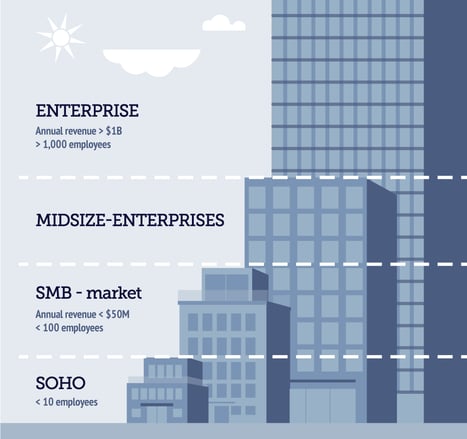
The SOHO (Small Office/Home Office) is the segment where businesses have between one and ten employees. SOHO companies can have complex needs but only have small budgets for customization and implementation. Seldom do they have internal and dedicated IT competencies.
The small and medium-sized businesses (SMB) market, with companies with less than 100 employees and less than $5 million in annual revenue, may have more complex business processes, internal IT resources and also some budget for customization, implementation and ongoing support.
The midsize-enterprise market, with companies ranging from 100 to 1,000 employees and producing annual turnover between $50 million and $1 billion, often has multi-site locations and operates across geographical borders. They have historically made significant investments in ERP software, customization, integration and implementation.
The Enterprise segment includes the largest organizations in the world. They are generally very complex organizations with many layers of management and operate from many locations across the globe. This segment accounts for the most significant ERP projects and shows off some of the biggest budget overruns and failures.
A vertical perspective
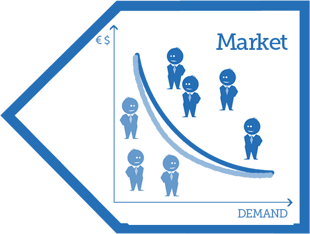
Segmenting the demand side of a market horizontally, according to the size of businesses, gives some indication of their complexity and spending potential. Still, it ignores the fundamental differences that exist across vertical industries.
There are substantial differences between running a hairdresser, a retail outlet, an e-shop, an engineering company, a leasing firm, a manufacturing facility, a marketing agency, a fishing trawler, a farm, an auction house, a hospital etc. Each industry has specific processes which affect its needs for business software functionality.
Growing your business from 10 to 25 or 400 to 800 employees may not change your software needs other than adding more users. Expanding your existing business by doing more of what you already do isn’t a significant indicator of changes in your needs. Adding more locations and international operations will introduce new complexity. Still, the real changes come from introducing new products, ways of serving your customers and how you organize your supply chain and business model. In my opinion, the demand side of the business management software market cannot be adequately described by the simple horizontal segmentation offered in the above illustration. Using company size only is not sufficient to determine the need for software functionality. Also this is also not how customers see themselves.

Segmenting the market according to what businesses do will give clusters where business processes are more alike, and companies, therefore, have similar needs for software functionality. We seldom see such segmentation because it is far more complex. A meaningful vertical segmentation will have many more layers than the four horizontals included in the illustration above. The North American Industry Classification System (NAICS) revision for 2017 has 20 top-level categories. However, manufacturing, which is very complex and software-intensive, but covers a range of variations, is just one of these. Each top-level class has sub-categories, and the total number of vertical industries in NAICS is 1,057. Combine the horizontal and the vertical segmentation, and you end up with 4,000 clusters.
Check out what industry-fit functionality is important for the automotive industry.
Complicated?
Maybe, but it is a much more accurate picture of the real world than just sorting all businesses and organizations into four categories.
Best-of-breed
- Managing change is difficult.
- Managing change that also involves new software is very difficult.
- Managing change that requires anyone in the organization to support a single monolithic software product is extremely difficult.
The amount of literature documenting what can go wrong is growing[3], and I think companies will want to learn how to reduce complexity and risk.

While the enterprise segment may still consider themselves very special and identify with their size, the SOHO, SMB and midsize-enterprise segments will increasingly identify with their vertical industry peers and be motivated to look for a Lego® approach with standard building blogs that are pre-integrated.
The best-of-breed approach, where a solution is made using components from many vendors, will be the preferred format. With this approach, new software can be introduced incrementally.
ERP projects that consumed two to three per cent of annual revenue and ran for years will be of the past. Instead, companies will continuously replace and introduce new software, but each project will be smaller and faster and involve fewer people. Less disruption, less risk and faster results.[4]
Companies may still spend substantially on the professional services associated with implementing business management software. However, it will be used for purposes other than application customization and spread evenly over the years as opposed to spending large amounts now and then.
Change management and implementing business software will become critical skills in any company. Those companies that can change fastest will gain a considerable competitive advantage, and in the future, all changes in value propositions and business processes will require software support.
Companies will still not buy into the technology hype, but they will be receptive to suggestions for improving their business models. Such recommendations must be concrete and illustrate how they improve customer value or internal productivity.
The supply side of the market
How will the supply side of the market (the industry) respond to the changes in demand?
The SOHO market vendors have already adapted to what customers are looking for, namely ease of use and price/performance. The winning format is the standard out-of-the-cloud solution that customers can implement themselves or with the support of a chartered accountant. Such solutions are pre-integrated with hundreds of applications that can be added according to each customer's specific needs.
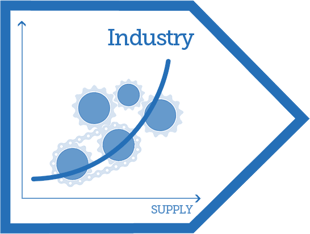
The global broad-line software companies that develop industry-agnostic software leaving it to Value Added Resellers (VARs), Independent Software Vendors (ISVs) and Systems Integrators (SIs) to complete, customize and implement will be challenged. By definition, they are technology-focused and driven by making something for which there is a vast market. Moving the focus from the technology hype to meaningful user functionality will not come easy for them. They depend intimately on how well their channels adapt to the new situation. While a big channel of independent VARs, ISVs and SIs makes for a powerful scaling tool, they become a liability when changes are required. Channel partners are more like cats than huskies. Herding cats is finicky.
The shift from on-premise to the cloud has opened the market for new suppliers targeting the SMB and mid-size enterprise segments. Some of these service customers directly, while others also use VARs, ISVs and SIs for sales and implementation. For good reasons, these insurgents have a much narrower market focus, and many are specializing in vertical segments.
Read or watch why Autostore choose RamBase as their ERP system
Implementing and using a multi-tenant SaaS product, becoming the preferred format, is very different from the old on-premise format that allowed for substantial changes in the core product. Besides changing configuration parameters and user-definable fields, fundamental changes in a SaaS solution have to be made outside the core system and exchange data through the API. These technical conditions lean themselves perfectly to the best-of-breed approach.
I expect that we will see the cloud-based vendors focusing on adding more core vertical functionality while leaving it to other industry players to offer peripheral modules that meet more generic needs and are easily integrated.
A product marketing narrative that speaks the language of the customer will have a considerable advantage over the current hype-based noise. Those vendors and channel partners that can translate the technology into practical improvements for their customers will find eager listeners.

A sexy place to be
Without an explanation of the sexy statement in the title of this article, you may accuse me of using clickbait. And that it is not :-).
You should look for the explanation of the difference between the industry analysts’ projection of software sales in the range of one trillion USD and the ten trillion USD that I expect the customers to spend. Where does the nine trillion USD go?
It goes to the thousands of VARs, ISVs, SIs and consulting companies that help the customers implement the software.
Implementation, however, will change in this decade compared to previous decades. I expect that we will see new types of implementation companies specializing in helping their customers prepare and implement the changes in their business processes. The focus is on the objectives first, then the processes and then the software. They will be brought in earlier in the process and work much closer with the customer’s business ambitions and organizational resources than before.
These service providers will bridge the knowledge gap between the software and the customers’ needs and will be increasingly vertical and industry-specific. Customers will prefer that their implementation partners are familiar with the software as well as business issues. For this combination of skills, they are prepared to pay attractive fees. Because the value of a successful implementation project always exceeds the cost. Always.
However, I am not sure that implementation partners will be software vendor agnostic. Helping companies with these types of projects require intimate familiarity with the software, and you don’t achieve that without getting your hands dirty.
If a ten trillion-dollar market isn’t worth looking at, what is? Money isn’t everything, but by offering a business management software implementation service with a vertical focus, you will find plenty of assignments where you can identify with the organisation's purpose and where the work is fun, rewarding and meaningful.
Hans Peter Bech
M.Sc. (econ.)
[1] http://resource.thirdstage-consulting.com/lessons-from-1000-erp-implementations-ebook
[2] https://www.qbsgroup.com/blog/elwis-has-left-the-building-goodbye-to-customization-of-erp-systems/
[3] Kim, G., K. Behr and G. Spaffford (2018). The Phoenix Project: A Novel about IT, DevOps, and Helping Your Business Win, IT Revolution Press.
[4] Kimberling, E. (2020). The 2020 ERP and HCM Report. T. S. Consulting. Denver, USA, Third Stage Consulting: 24.

COMMENTS